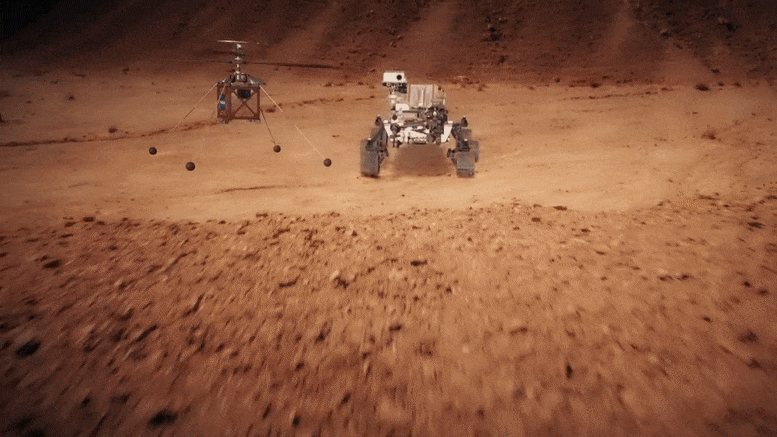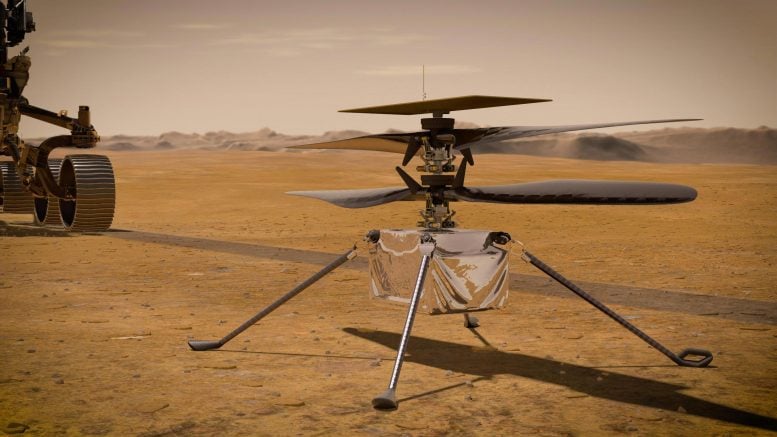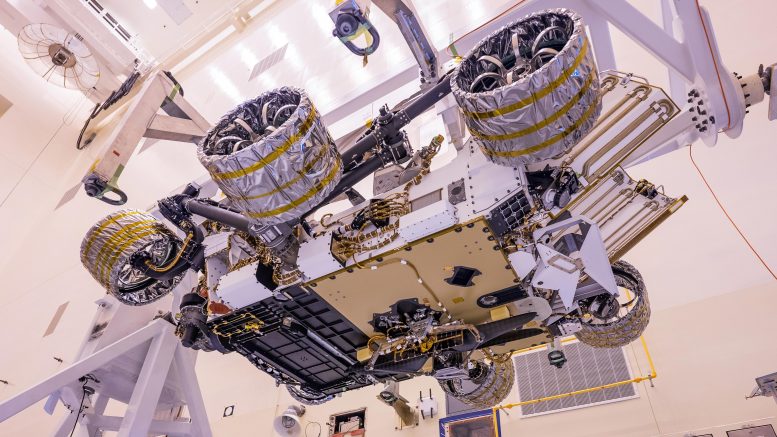
NASA Ingenuity Mars Helicopter
Ingenuity, a technology experiment, is preparing to attempt the first powered, controlled flight on the Red Planet.
When NASA’s Perseverance rover lands on Mars on February 18, 2021, it will be carrying a small but mighty passenger: Ingenuity, the Mars Helicopter.
The helicopter, which weighs about 4 pounds (1.8 kilograms) on Earth and has a fuselage about the size of a tissue box, started out six years ago as an implausible prospect. Engineers at NASA’s Jet Propulsion Laboratory in Southern California knew it was theoretically possible to fly in Mars’ thin atmosphere, but no one was sure whether they could build a vehicle powerful enough to fly, communicate, and survive autonomously with the extreme restrictions on its mass.
Then the team had to prove in Earthbound tests that it could fly in a Mars-like environment. Now that they’ve checked off those objectives, the team is preparing to test Ingenuity in the actual environment of Mars.

In this illustration, NASA’s Ingenuity Mars Helicopter stands on the Red Planet’s surface as NASA’s Perseverance rover (partially visible on the left) rolls away. Credit: NASA/JPL-Caltech
“Our Mars Helicopter team has been doing things that have never been done before – that no one at the outset could be sure could even be done,” said MiMi Aung, the Ingenuity project manager at JPL “We faced many challenges along the way that could have stopped us in our tracks. We are thrilled that we are now so close to demonstrating – on Mars – what Ingenuity can really do.”
Ingenuity survived the intense vibrations of launch on July 30, 2020, and has passed its health checks as it waits to plunge with Perseverance through the Martian atmosphere. But the helicopter won’t attempt its first flight for more than a month after landing: Engineers for the rover and helicopter need time to make sure both robots are ready.
Here are the key things to know about Ingenuity as the anticipation builds:
1. Ingenuity is an experimental flight test.
The Mars Helicopter is what is known as a technology demonstration – a narrowly focused project that seeks to test a new capability for the first time. Previous groundbreaking technology demonstrations include the first Mars rover, Sojourner, and the Mars Cube One (MarCO) CubeSats that flew by Mars.
The helicopter doesn’t carry science instruments and isn’t part of Perseverance’s science mission. Ingenuity’s objective is an engineering one: to demonstrate rotorcraft flight in Mars’ extremely thin atmosphere, which has just around 1% of the density of our atmosphere on Earth.
Ingenuity will attempt up to five test flights within a 30-Martian-day (31-Earth-day) demonstration window. Its pioneering aspirations are similar to those of the Wright brothers’ Flyer, which achieved the first powered, controlled flight on Earth.
NASA’s Ingenuity Mars Helicopter will make history’s first attempt at powered flight on another planet in February. It is riding with the agency’s next mission to Mars (the Mars 2020 Perseverance rover). Perseverance, with Ingenuity attached to its belly, will land on Mars on February 18, 2021. Credit: NASA/JPL-Caltech
2. Mars won’t make it easy for Ingenuity to attempt the first powered, controlled flight on another planet.
Because the Mars atmosphere is so thin, Ingenuity is designed to be light, with rotor blades that are much larger and spin much faster than what would be required for a helicopter of Ingenuity’s mass on Earth.
The Red Planet also has beyond bone-chilling temperatures, with nights as cold as minus 130 degrees Fahrenheit (minus 90 degrees Celsius) at Jezero Crater, the rover and helicopter’s landing site. These temperatures will push the original design limits of the off-the-shelf parts used in Ingenuity. Tests on Earth at the predicted temperatures indicate Ingenuity’s parts should work as designed, but the team is looking forward to the real test on Mars.
“Mars isn’t exactly pulling out the welcome mat,” said Tim Canham, Ingenuity’s operations lead at JPL. “One of the first things Ingenuity has to do when it gets to Mars is just survive its first night.”

The Mars Helicopter, visible in lower center of the image, was attached to the belly of NASA’s Perseverance rover at Kennedy Space Center on April 6, 2020. The helicopter will be deployed onto the Martian surface about two-and-a-half months after Perseverance lands. Credit: NASA/JPL-Caltech
3. Ingenuity relies on the Mars 2020 Perseverance mission for safe passage to Mars and for operations on the Red Planet’s surface.
Ingenuity is nestled sideways under the belly of the Perseverance rover with a cover to protect it from debris kicked up during landing. Both the rover and the helicopter are safely ensconced inside a clamshell-like spacecraft entry capsule during the 293-million-mile (471-million-kilometer) journey to Mars. The power system on the Mars 2020 spacecraft periodically charges Ingenuity’s batteries on the way there.
To reach the Martian surface, Ingenuity rides along with Perseverance as it lands. The rover’s entry, descent, and landing system features a supersonic parachute, new “brains” for avoiding hazards autonomously, and components for the sky crane maneuver, which lowers the rover onto Mars from a descent vehicle. Only about 50% of the attempts to land on Mars, by any space agency, have been successful.
Once a suitable site to deploy the helicopter is found, the rover’s Mars Helicopter Delivery System will shed the landing cover, rotate the helicopter to a legs-down configuration, and gently drop Ingenuity on the surface in the first few months after landing. Throughout the helicopter’s commissioning and flight test campaign, the rover will assist with the communications back-and-forth from Earth. The rover team also plans to collect images of Ingenuity.
4. Ingenuity is smart for a small robot.
Delays are an inherent part of communicating with spacecraft across interplanetary distances, which means Ingenuity’s flight controllers at JPL won’t be able to control the helicopter with a joystick. In fact, they won’t be able to look at engineering data or images from each flight until well after the flight takes place.
So Ingenuity will make some of its own decisions based on parameters set by its engineers on Earth. The helicopter has a kind of programmable thermostat, for instance, that will keep it warm on Mars. During flight, Ingenuity will analyze sensor data and images of the terrain to ensure it stays on the flight path designed by project engineers.
5. The Ingenuity team counts success one step at a time.
Given Ingenuity’s experimental nature, the team has a long list of milestones the helicopter must reach before it can take off and land in the spring of 2021. The team will celebrate each milestone:
- Surviving the cruise to Mars and landing on the Red Planet
- Safely deploying to the surface from Perseverance’s belly
- Autonomously keeping warm through the intensely cold Martian nights
- Autonomously charging itself with the solar panel atop its rotors
- Successfully communicating to and from the helicopter via a subsystem known as the Mars Helicopter Base Station on the rover
If the first experimental flight test on another planet succeeds, the Ingenuity team will attempt more test flights.
NASA’s Mars Helicopter, Ingenuity, is set to arrive at the Red Planet on February 18, 2021. Its mission: to demonstrate the first powered flight on another world. Credit: NASA/JPL-Caltech
6. If Ingenuity succeeds, future Mars exploration could include an ambitious aerial dimension.
Ingenuity is intended to demonstrate technologies and first-of-its-kind operations needed for flying in the Martian atmosphere. If successful, these technologies and the experience with flying a helicopter on another planet could enable other advanced robotic flying vehicles that might be part of future robotic and human missions to Mars. Possible uses of a future helicopter on Mars include offering a unique viewpoint not provided by current orbiters high overhead or by rovers and landers on the ground; high-definition images and reconnaissance for robots or humans; and access to terrain that is difficult for rovers to reach. A future helicopter could even help carry light but vital payloads from one site to another.
More About the Project
JPL, a division of Caltech in Pasadena, California, manages the Ingenuity Mars Helicopter technology demonstration for NASA. JPL also manages the Mars 2020 Perseverance project for NASA.









THANKS FOR THE INFORMATION. I AM SO LOOKING FORWARD TO THE LANDING TO SEE ALL OF THE SUCCESSES YOU HAVE ACCOMPLISHED BESIDES GETTING TO MARS.
Notice in the article, not a word said about the dangers of the Mars dust.
I predict that it will quickly meet with disaster, because of the Mars regolith NANO-DUST.
Pastry flour consistency and electrostatically CLINGY. Microscopic jagged edges (due to no water) will destroy the spinning bladed machinery in a short period of time.
My question is why sink all this money into a helicopter, and not into a ‘space terrarium’, to see exactly how life would do there?
Have you ever wondered why, in all these Mars landings, not ONE living organism has ever been sent along, nor left behind, to see how it would fare?
Yet showman Musk wants to jump the gun, and send humans to their deaths, most likely enroute, if not shortly after arrival?
Because…
Humans in deep space + cosmic gamma radiation + Mars nano-dust = GAME OVER. Period.
There’s simply no way to economically shield from gamma radiation. It’s like nano-wrecking balls to the DNA.
Forget reproduction.
A wall of water 15ft thick would be required. Spacesuits won’t properly shield from it.
Airlocks and spacesuits may keep out most of the nano-dust, but not all of it. And in a short period of time, it will get into EVERYTHING, creating an ‘asbestosis’-like respiratory condition.
Due to these two very obvious ‘elephants in the room’, it is easy to see that cancer and a painful death await each and every eager volunteer to the Red Planet.
Well said Darwin! I totally agree with you my friend on the nano dust. Also the dust devils on Mars radiation gamma cold and thin atmosphere no magnetic field. I really liked how you said no living organism to test the planet. I’m not negative of what could be done but it’s so much to test before humans to set foot on Mars it’ll be an bad risk. I’m not negative I love NASA and space but my friend you really put everything on point in commonsense explained.
This is exciting. But why do you use measurements in meters? How about using “feet” so we can understand what you are talking about?
For some, meters are preferable over feet. The SI system is also used a lot in scientific measurements. To allow everyone to easily understand, you could write meters and feets too, so no one can atue aboit that.
I mean, “argue about”
Earth is a closed system, nobody will go there.
Darin, I just wish you would just disappear. Typical lib, I know everything, you don’t. Have you read what has been said, this is a test.maybe they’ve already thought about these long before you did.Also stop complaining about Mr. Musk. He’s so much more relavent than you will ever be
Thank you, Charles. Obviously there will be challenges when we go to Mars, but there will be way smarter people than you working to fix them, Darin. People worried that when going to the moon that the lander would sink into the dust and kill the astronauts, but they made precautions in case that was true and it was fine. We didn’t not climb mount everest because it was too cold or high either. When faced with challenges, humans will prevail. Also, quit dissing Elon Musk. He has made putting things into orbit way cheaper and already has done what was thought impossible by landing orbital rocket boosters.
Darin, you may be making very good and valid points. Do you think NASA would have not worked out these points , before entering into a mission. There will be a lot of research gone in to get what they are doing with MARS. I love space and I will also be doing a startup soon , to explore MARS. I really appreciate NASA for all success on ingenuity too.
Talking about Elon, he is really making humans think beyond, and he is achieving results. And he is really getting NASA to think too, he says a manned mission to MARS by 2026. I am really excited to see how this goes.
Basically I am from India, I am very unhappy with ISRO, as we are still exploring at orbiter level. We are not there for a touchdown. I am very disappointed with ISRO. Chief of ISRO says, a touchdown is very difficult to execute. This validates NASA has done a extremely good job.
I love space, space excites me. Bye for now.
I think Elon can handle the criticism.
I cheer each time he takes the reigns and accomplishes something space related. I was so excited as a child in the 70’s about our prospects of exploring space, and then….
The problem with eccentric billionaires is that there are not enough of them interested in space. It sure would be nice if there was an agency funded by taxpayer dollars, advised by scientific advisors, populated by skilled engineers that exists apart, and insulated from the fickle whims of politicians. Instead, we have Elon. I hope he never decides to retire or take up finger painting, else there goes our space agency. Maybe the Russians can give us a ride…depressing.
In other news, we have a cool helicopter on mars!